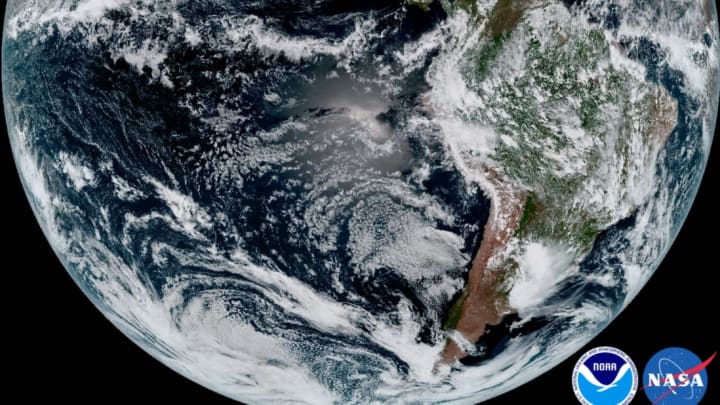5 Strange Facts About the Planet Earth

by Alex Carter
You know what it’s like: You live somewhere all your life but never realize just how great it is until someone comes to visit. While it’s just a shame we don’t get any visitors to marvel at all the peculiarities of our home planet, here are five facts you might still appreciate.
1. EARTH'S A GIANT DYNAMO.
The core of the Earth is a solid lump of nickel and iron, rotating in a sea of molten iron and nickel. This rotation functions the same way winding up a hand-held generator does, giving Earth an enormous magnetic field that extends up to 50,000 kilometers out into space. This magnetic field is crucial for life on Earth, as without it we would be exposed to the full force of the Sun’s radiation. As well as causing cancers and other radiation-aggravated conditions, the radiation's sheer force would blow our atmosphere into space, as happened with Mercury, and to a lesser extent, Mars. Instead, charged particles are (mostly) harmlessly deflected away, giving rise to the auroras.
It’s not all good though: Any particles that hit the Earth head-on tend to get trapped in the field and can’t get out. These so-called Van Allen Radiation Belts can pose a hazard for astronauts who leave low Earth orbit.
2. IT'S THE DENSEST PLANET IN THE SOLAR SYSTEM.
While Earth may not be the biggest planet in the system, it is the biggest rocky planet in the solar system, and also the densest. Therefore, Earth has by far the highest surface gravity of any terrestrial object in the solar system. This is both a blessing and a curse.
The reason for the high density is the large deposits of heavy elements in the Earth’s makeup. Elements such as lead and uranium are much rarer on other worlds, which gives us a huge advantage in the amount and variety of construction materials available here on Earth. The high gravity has also demanded that humans develop the reflexes and endurance necessary to cope with such gravity, meaning we are far more durable than the potential delicately boned, sloth-like creature we could be had we evolved in low gravity.
Unfortunately, that high gravity makes Earth the worst place in the solar system for space exploration. The sheer cost of overcoming Earth’s gravity during every launch has been the single biggest barrier to space travel. To put it into perspective, if the Earth only had the same gravity as the Moon, a typical airplane would be fast enough to get into orbit. The human race might have explored much more of the solar system using present day technology if we had lower gravity—although, of course, the weakness of low-gravity humans might have proven to be an equal barrier.
3. THE MOON IS DISPROPORTIONATELY HUGE.
Most planets in the solar system have moons, and our moon may not be the biggest of them, but in comparison to Earth's size, it's enormous. Most scientists think that rather than coalescing on its own like the other large moons, it was violently shorn off Earth billions of years ago by a collision between Earth and another planet. The impact—with a planet about the size of Mars—liquified Earth in the heat, and the Moon broke off, gradually cooling into a ball of rock. New research suggests that not just one but multiple collisions may be responsible for its formation.
The Moon’s size and distance are a giant cosmic coincidence, allowing us on Earth's surface to experience total eclipses, annular eclipses, and partial eclipses, all from the comfort of our own planet. If the Moon were smaller or farther away, we wouldn't see any sort of eclipse at all.
The Moon is also an important tool for scientists trying to better understand Earth's composition. Starting with all the same raw materials, except for the magnetic field, the Moon cooled, geological activity stopped, and the solar wind blew away what atmosphere there was. Now, the surface is littered with craters which could not be healed, like scars. And the razor sharp soil sticks to everything, even the radiation coming in from the Sun. (Seems like we got the better end of that deal.)
4. WE LIVE ON A GIANT NUCLEAR FURNACE.
Take a spade to many points on the Earth’s crust and you might dig up a selection of radioactive elements. While we might think of the Earth’s magnetic field as protecting us from radiation, it does little to protect us from what’s right under our feet.
Most of the radioisotopes on Earth reside in the core, where the heat from their decay keeps the core molten, the tectonic plates moving, and the dynamo deep in the Earth rotating. If it weren’t for radioisotopes, the core would cool, the magnetic field would disappear, and the Earth would slowly become uninhabitable. There is another consequence of all these radioactive elements, though. In Oklo, Gabon, it was discovered that the uranium mines contained significantly less uranium-235 (the kind used in nuclear reactors and weapons) than the other isotopes. The startling conclusion was that the reserves had been used over millions of years in a naturally occurring nuclear reactor.
5. IT IS THE ONLY PLANET KNOWN TO HAVE LIFE.
Despite current attempts to find other habitable planets, Earth is the only place in the universe we can be sure that there is life. With liquid water, oxygen, and plenty of sunlight, we really lucked out. But with recent findings of water on Europa and Callisto, Jupiter's moons, we have new hope that someday we'll find another planet capable of supporting life.